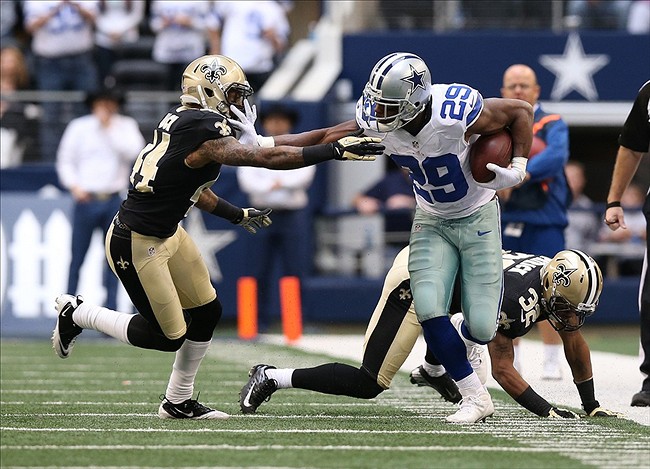Fitz on Fantasy: Drafting Tactics From A Bird’s-Eye Perspective
This might be my favorite time of year for fantasy football, even though we aren’t playing actual games. Most drafts and auctions are still a few weeks away, but as we prepare for the critical talent-acquisition phase of the fantasy season, we have the luxury of being able to take a bird’s-eye view of the player population. We don’t have to focus on problem-solving and lineup maximization and can instead broaden our perspective and look at everything. The fantasy-football world is our oyster, and we don’t have to deal with that messy shucking business just yet. (Ever shuck oysters? It’s murder on the hands.)
But while we’re enjoying the helicopter view that late summer affords us, it’s easy to forget about the week-to-week demands of our little game. Plans go awry and things get messy. To adequately prepare for a draft or auction, come down from on high and position yourself in the trenches. Let’s get into a ground-level frame of mind with some ground-level thoughts:
Positional balance is overrated:
Most fantasy owners go into their drafts and auctions with the overarching goal of putting together a balanced team, one without weakness at any position. But fantasy football rosters aren’t static once the season begins. You can add emerging contributors from the pool of unowned players, and you can make trades.
Why do owners typically make trades in-season? It’s usually because something has gone haywire (a player has gotten hurt or benched), leaving the owner underpowered at one or more positions. If this happens to a “balanced” team, the only way for the owner to patch the hole is to sacrifice strength in another area. The problem is that a balanced team rarely has a surplus of strength at any position. An owner in a situation like this has precious little leverage in trade negotiations.
By no means is it a tactical sin to overload at a position. Smile pleasantly at your fellow owners (or in an online draft, give them a winking emoticon) when they question your sanity. “But you already have LeSean McCoy and Steven Jackson. Why would you draft Frank Gore in the third round?!”
Because you want to kick that owner’s ass this season, that’s why. And you don’t have to slow down from there. Seek additional opportunities to add to your RB reserves. You can be to running backs what Colombia is to coffee.
OK, but now your starting wide receivers are Steve Smith and James Jones. That’s not ideal. No, it isn’t, but it’s hardly a disaster. That’s a good enough tandem to win with for a couple of weeks until you start to leverage your RB strength with the owners who’ll be pleading with you to part with one of your running backs. And plead they will. Calvin Johnson is destined to be picked ahead of Steven Jackson in just about every fantasy draft this year. But once the season begins, it’s not inconceivable that you could flip S-Jax for Megatron straight up if the Megatron owner was desperate for RB help. (I traded Calvin for C.J. Spiller last year after RB disaster struck me in one league.)
The positional-overloading strategy isn’t limited to running back, but that’s where it works best. The QB pool is deep; most of your rivals will have no trouble finding contentment there. The TE position is thin at the top but deep with capable candidates. Wide receiver is a deeper position than running back simply because most NFL teams have more receivers making weekly contributions than running backs.
Good running backs are always in demand, and leveraging that demand is sound strategy.

Load up on those upper echelon running backs!
Inner-positional balance is underrated:
While positional balance is overrated, balance within the RB and WR positions is a worthy goal. Think of yourself as a master sommelier in this regard. Some wines pair brilliantly with certain foods, poorly with others. A good steak demands a bold, full-bodied red — a cabernet or a zinfandel — and not some delicate red or (yeesh) a white.
But speaking of whites, let’s say the first wide receiver you draft is Roddy White, one of the most consistent pass catchers around. You can count on him to make at least a decent contribution most weeks. He doesn’t have as many explosive scoring days as some of the other top receivers, but rarely does he just disappear. With the dependable White as an anchor at WR, it might make sense to pair him with a receiver who comes with a high upside but a degree of risk (Mike Wallace, for instance) rather than another steady-Eddie type from the same WR tier (Wes Welker comes to mind). Opposites on the consistency scale tend to pair well together. White’s stability can help you cushion volatility and absorb risk — and a little risk isn’t a bad thing if the potential rewards are substantial enough.
Suppose instead that the first receiver you draft is Vincent Jackson, who tends to oscillate between huge games and poor ones. It might make sense to seek stability in your No. 2 receiver. A consistent performer such as Reggie Wayne might make more sense than the boom-or-bust Hakeem Nicks.
Pairing together different types of fantasy backups can help you spread your bets. Ben Tate and Pierre Thomas have similar ADPs and might complement each other well as your backup running backs. Tate could provide a potential windfall if Arian Foster were to get hurt, but Tate offers little when Foster is healthy. Thomas is stuck in the Saints’ RB-by-committee and thus has a low ceiling, but he at least gives you something every week if you’re in a pinch. Tate is a swing-for-the-fences pick, the kind of pick that could add rocket fuel to a championship drive if you get a little lucky. Thomas is a safety play, the kind of finger-in-the-dyke option that can sustain you for a week or two when the situation is dire and keep playoff hopes alive.
Fear not the brittle:
Yes, of course it makes sense to take a player’s medical history into account when assessing his value, but don’t be a mincing little fraidy cat about it. Maurice Jones-Drew’s ability to make a strong return from a serious foot injury is valid cause for concern, and hence only an Evel Knievel-type daredevil would hazard a top-10 draft pick on MJD. But to drop Jones-Drew to the nether regions of your RB rankings would be an overreaction.
Obviously, losing a player to injury doesn’t mean that you have to take zeroes in his lineup spot until he returns. A substitute from your bench or from the free-agent pool may not have the same value as your injured regular, but the sub has replacement-level value, which is at least something.
Let’s consider Chargers WR Danario Alexander, whose knee ligaments have been woven and rewoven together like the material in a bird’s nest. Where would you draft Alexander if he weren’t considered a major medical risk? Let’s say he’d rank about 20th among wide receivers, in the same neighborhood as fellow home-run hitter Torrey Smith. Suppose you draft Alexander and start him regularly, and suppose your top backups are Kendall Wright and Alshon Jeffery, who both might offer production in the mid-40s among WRs. If you anticipate some missed time for Alexander, your expected productivity for his lineup spot is going to fall somewhere between WR20 and, say, WR45. If Alexander remains intact for most of the year, productivity for that spot will be closer to WR20. If he wrecks his knee early on, productivity for that spot will be closer to WR45 (the replacement-level value or Wright and/or Jeffery). But WR45 wouldn’t be a total disaster, and injury risk is already baked into Alexander’s very reasonable ADP of WR34.
Exercise sleeper selectivity:
Everyone loves talking about potential sleepers this time of year. If you follow the work of a dozen or more fantasy writers, you’re going to see compelling cases made for scads of potential sleepers. If you’re in an average-sized league — say, 12 teams with 16 or 18 roster spots — you can’t afford to run amok with sleeper speculation. You might feel like a kid in a candy store, but if you don’t get your proteins, fruits and veggies, you’re going to crash.
Sleepers typically qualify as such because they don’t yet possess clear roles. It won’t be long before the bye weeks arrive and the injuries start to mount, and you’re going to need able backups. You probably can’t afford to carry 3-4 sleepers who are all waiting for their chance in the limelight. Settle on a few favorite sleepers and limit yourself to one or two in a single draft.
You can’t afford too many Golden Slumbers; you need players who can Carry That Weight, lest your team prematurely come to The End.
See also: Fitz on Fantasy: Complete Preseason Rankings
See also: Fitz on Fantasy: Thirteen Overvalued Players for 2013



